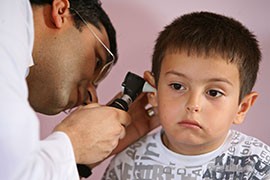Cronkite News has moved to a new home at cronkitenews.azpbs.org. Use this site to search archives from 2011 to May 2015. You can search the new site for current stories.
More Arizona kids on ‘Obamacare,’ but experts aren’t sure why
WASHINGTON – Health experts know that Arizona has the nation’s highest percentage of children enrolled in the federal health insurance marketplace.
But who those children are, and why they’re enrolling, seems to have even the experts stumped.
Theories include possible demographic issues, family composition or the demise of the state’s KidsCare health insurance program for needy families – or, said one, it could be just a fluke.
The Department of Health and Human Services reported Thursday that about 25,000 of Arizona’s 120,000 enrollees in the federal marketplace through the March 31 end of the first enrollment period were under 18 years old.
Many experts said the numbers of children who turned to the federal marketplace in Arizona could have been driven up by the state’s near elimination of its children’s health insurance program, known as KidsCare.
That Medicaid-funded program provided health insurance to children whose families’ income was between 133 and 200 percent of the federal poverty level.
But the state froze enrollment in 2010, and the program now only covers about 2,000 children. When a temporary successor, KidsCare II, ended this year, state officials pointed those children to the Obamacare marketplace.
“Basically now, because KidsCare (would have) covered up to 200 percent of the federal poverty level, there’s a gap between 133 percent of the federal poverty level and 200 percent of the federal poverty level,” said Daniel Derksen, director of the Center for Rural Health at the University of Arizona,
“And that’s the group that’s being told, ‘Go buy a plan on the marketplace,’” Derksen said. “That’s what the parents are being told.”
Derksen added that Arizona was not in a great place to begin with: It had the third-highest percentage of uninsured children in 2012, trailing only Nevada and Alaska.
Cheryl O’Donnell, the Arizona director of Enroll America, agreed that because Arizona is a low-wage state without a children’s health insurance program as an option for needy families, many parents may be opting to insure their children through the federal marketplace.
But she pointed to another possible reason for the large share of children enrolling in Arizona – mixed-status families, or those in which the children are U.S. citizens but one or both of the parents are not.
O’Donnell said such parents can enroll their children without being citizens themselves, but that getting those families to the insurance marketplace has been difficult.
“How do we get over the barrier of communicating to mixed-status families where we know that there are children who are U.S. citizens that could benefit from these programs, but you have parents who are too afraid to engage with the system for fear of being deported?” O’Donnell asked.
Edmund F. Haislmaier, a senior research fellow at the Heritage Foundation who specializes in health-care policy, said there is not yet enough data to draw firm conclusions on what is driving enrollment of children. But he said the experience in other states with high numbers could shed light on what is happening in Arizona.
Haislmaier said the presence of Native American populations who aren’t poor – he pointed to the Navajo Nation – might contribute to the number.
“When you think about Idaho or particularly Arizona and North Dakota, that might be a factor, given that they can essentially sign up at any time for free exchange coverage,” he said.
Haislmaier added that larger families might also have something to do with the high number of children enrolled citing Utah’s under-18 enrollment of 18 percent, third-highest in the nation.
“Or it may just be a fluke,” he said.







